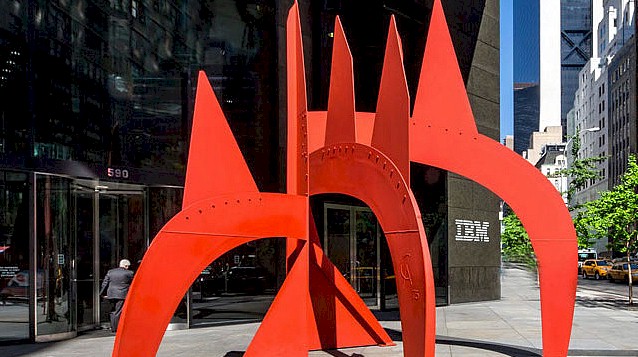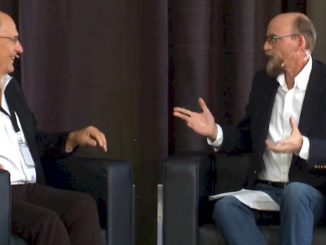
Let’s get one thing straight right off the bat. If someone has been named president of International Business Machines Corporation, it means they are the heir apparent and future chief executive officer of what used to be the world’s largest IT supplier. Which is why the announcement of the departure of Jim Whitehurst from IBM on the Friday before the Independence Day holiday in America started was such a surprise.
Someone at the company forgot what being named president of the IBM Company means. Or no longer cared.
That someone is very likely current CEO Arvind Krishna, who was given that role back in January 2021, when the company’s board of directors also named Whitehurst president. Whitehurst came to IBM after being CEO at Red Hat, the open source software giant – the only open source software giant if you want to be precise – that IBM paid $34 billion to acquire in October 2018. Perhaps Krishna, who is 59 and already coming up against the traditional retirement age of 60 for IBM’s chairman and CEO, has decided that he is best to run Big Blue and that the person who ran Red Hat for more than a dozen years, who was chief operating officer for Delta Air Lines for six years (covering ops as a well as the CIO role), who was a partner at the Boston Consulting Group for a dozen years, and who got a double major in computer science and economics from Rice University and an MBA from Harvard University, is not.
To be fair, that someone who forgot the meaning of the president title at IBM could have been the company’s board, it could have been the other members of the executive management team at Big Blue, or it could have been Whitehurst himself. Or maybe all four vectors at once.
The upshot is we will never know what that future IBM, one that brought the sensibilities Whitehurst has developed in his long career from outside of Big Blue, could have been. We expected transformation, and because there is precedent for bringing outsiders inside Big Blue to help transform it, as former chief executive officer and chairman Louis Gerstner masterfully did when he was brought in from American Express to literally save its corporate life on April Fool’s Day 1993. There is an equally important one which we will explain below, and Whitehurst could have been the third.
Those of us who have been around for a long time and who watched IBM very carefully know exactly how dire IBM’s situation was in the late 1980s and early 1990s, as the entire computer business was shapeshifting and the world as Big Blue knew it suddenly collapsed. Back then, mainframe and minicomputer demand dried up and the Unix open systems revolution took the corporate datacenters of the world by storm. It was hard to watch IBM’s death spiral, and that is what it truly was.
In the late 1980s, at its peak, IBM had well over 400,000 employees and half of them were in the United States. In 1991, IBM shed around 30,000 employees and booked a $3.4 billion charge, pushing it to report a $2.8 billion loss. In 1992, IBM’s revenues shrank a bit, but it lost nearly $5 billion and the employee count dropped nearly 43,000, just above 300,000 people worldwide. The following year, 1993, was just awful for IBM, with revenues trending down by a few points and IBM shedding another 45,000 employees and posted a stunning $8.9 billion in restructuring charges and an $8.1 billion loss against $62.7 billion in sales. Chairman and CEO John Akers retired in April that year and Gerstner was brought in to replace him. The next year, IBM was able to boost revenue by two points to $64 billion and actually posted a $3 billion profit, but the layoffs continued and the employee count shrank by 36,000 to 220,000.
This was the first time an outsider ran Big Blue aside from Thomas Watson himself, when he joined the Computing-Tabulating-Recording Company in May 1914 after a long stint at National Cash Register to be its general manager and nearly a year later was named its first president. CTR was eventually rejiggered, with meat slicers and scales sold off and it focused on the punch card tabulating gear that turned it into the first iteration of what we know as IBM. Gerstner rejiggered IBM in a different way, putting its services and software front and center and opening both up to competitive IT platforms while making its four platforms – mainframes, proprietary minicomputers, Unix minicomputers, and X86 servers – open to running operating systems, middleware, and applications created by others. The commercial Internet and the dot-com boom and the “e-business” explosion in the wake of this helped keep IBM alive for another decade. Gerstner retired a hero and joined private equity firm The Carlyle Group.
To one way of looking at it, IBM’s situation is not as bad now in 2021 as it was starting in 1991. But to another way, IBM is a lot less relevant today than it was in the early 1990s, and Red Hat was exactly the big transfusion of fresh blood that IBM needed to revitalize and change itself. Whitehurst was without question one of the big assets that Big Blue got in the deal, and it was no doubt a goal of former IBM president, chief executive officer, and chairman Ginni Rometty, who preceded Krishna and Whitehurst in their roles, to see Whitehurst eventually – and we think sooner rather than later – take the helm. We fully expected for Krishna to be chairman for several years, by the way, before Whitehurst assumed that role.
The precedent for presidents is clear here at IBM, and it is important to point this out. Whatever happened with Whitehurst violates that precedent, which means it had to be pretty significant. While it is true, as has been reported, that Whitehurst, who is 54, wants to be CEO at a company before he retires, the CEO job he undoubtedly thought he would have – and that any IBMer and IBM watcher already thought he had – was the future CEO at IBM.
Thomas Watson, who is called IBM’s founder but that’s a bit fuzzy if you look into the long history of the companies that make up IBM, all the way back to Hermann Hollerith’s punch card tabulators that were used in the US Census in 1890, was succeeded by his son, Thomas Watson, Jr, who was named president in 1952 and CEO when his father died in 1956. This was when IBM was transforming itself into the mainframe computer maker that made it a household name and fabulously rich by any corporate standards you care to bring to the table. Vin Learson was named IBM president in 1966 and was chairman and CEO from 1971 through 1973. Frank Cary was named president in 1971, with Learson approaching the mandatory 60 retirement age in 1973, when Cary was then named chairman and CEO. Cary was CEO until 1981 and chairman until 1983. John Opel was named president in 1974 under Cary and took over as CEO and chairman when Cary relinquished those roles. John Akers was named president in 1983 and two years later was named CEO and chairman when Opel stepped down. IBM did not initially have a president when Gerstner came in, but Akers had an assistant named Sam Palmisano who Gerstner took a shining to, and in 2000 he was named president, in 2002 he was named CEO, and in 2003 he was named chairman. As Palmisano approached the 60 retirement age, Ginni Rometty was named president and CEO in early 2012 and chairman in late 2012. When Rometty relinquished her president and CEO roles in January 2020, Krishna was named CEO and Whitehurst president, and she stepped down as chairman in December 2020 and Krishna took on that role.
The split CEO/president roles that Rometty implemented across two people in one fell swoop is unusual in IBM’s history; these roles usually change in series, not in parallel. And Rometty did stay beyond age 60 in the CEO role, which she relinquished on April Fool’s Day 2020 at the age of 62 (and almost 63, in fact). So there is precedent for Krishna staying on board for at least a few more years. (And maybe 60 is not as old as it used to be and maybe 65 is a better cutoff that IBM should consider anyway for the retirement of its CEOs.) All that said, it was reasonable to expect that Whitehurst would be CEO and wield the power while Krishna would be chairman and provide the IBM historical context. Krishna has been calling all the plays since Rometty stepped down, including selling off a big chunk of the services business and focusing down on the hybrid cloud message. Neither is particularly exciting to Wall Street or customers, even if the latter is indeed how computing will be done for most of the large enterprises that Big Blue cares most about.
Prior to the Red Hat acquisition, IBM did not have a platform that captures the imagination and it did not have a story to tell, and Red Hat definitely gave it both of those. We wonder why Whitehurst is not the one who is going to be calling the plays and relaying that message to the world. Given his experience as consultant, CIO, and CEO of a major software company that has shaken up the enterprise, it is a wonder indeed. And we wonder what kind of IBM might have emerged under Whitehurst’s guidance a few years hence. IBM will persevere, and Red Hat is still a wonderful asset, but Big Blue cannot be the same after this. It will be a little less red and a little more blue, at the very least.
In other IBM reorganization news, Tom Rosamilia, who we always thought might be president and CEO at Big Blue, has been put in charge of the Cloud and Cognitive Software group at the company – the role that Krishna held when Rometty did the Red Hat deal. Ric Lewis, who used to run Hewlett Packard Enterprise’s Mission Critical Systems division has been brought in to run Systems group, replacing Rosamilia. Bridget van Kralingen is retiring and has stepped down as head of Global Markets, a group and division spanning marketing and sales role, and Rob Thomas, who has run various hardware and software units, has taken over that role.





It happened because, well, IBM is simply fading to irrelevance. All it has going for itself is “historical context” 😉
Who’s IBM?
If I remember when Jim Gray left IBM, he did qualify IBM as very conservative. When Lou Gerstner took the helm he trasnformed the compagny into a very successful integration company with openness. Then came Palmisano and Rometty, and IBM became irrelevant again although I still consider that IBM has still an upper edge on IT technologies (MF, Power, OS/400, Q, AI, etc). The acquisition of RH was a kind of poker shot (and probably a financial issue) but the now vision is still weak and indefinable for customers except a basic understanding : IBM is IBM (sigh). If Mr Whitehurst was not named CEO/President it’s because, well you can guess it : Lou Gerstner did integrate The Carlyle Group after having retired from IBM. Kind regards
When compute switched from large systems to small, the mainframe seemed less relevant. Now that things are switching to cloud it’s as if timesharing and mainframes have returned.
More interestingly, Linux has allowed Amazon, Oracle and others to switch to mainframe sized ARM servers in their clouds.
I see two possible futures: either yield and performance problems will be so bad with the 7nm Power10 that they instantly go bankrupt or they could hire Timothy to turn things around.
What Whitehurst forgot is that many years ago, IBM declared war on US employees in general and US employees over 50 specifically. I will be very surprised if IBM has an American as CEO/Chairman ever again.
Just a note that a mainframe is not just a “big” computer, it is a particular kind of computer design that prioritizes high I/O throughput over low latency.
Think of all the big web-based systems like search engines, social media services and the like — they all put low latency as number one. So the massively parallel load-balanced and fault-tolerant computing facilities that they run on are as different from “mainframes” as can be. They not only need to respond quickly, they also need to adapt quickly to shifting loads — again, something that was never envisaged in the design of mainframes.
Are there any significant workloads left where mainframes have an useful advantage? Somehow, I don’t think so…
It’s a niche market, but banks and transaction processing are likely to continue using mainframes for the foreseeable future. One of the few remaining advantages of mainframes is the ability to run ACID compliant relational databases at immense scale, where distributed systems generally use noSQL databases and eventual consistency (which isn’t good enough for financial use cases).
What I envision happening is that IBM and the System/Z platform will hang on milking their old customers for the foreseeable future. If they can develop and adapt the platform to new use cases, they *might* be able to get some new customers, but more likely I expect their mainframes to just hold onto existing markets or shrink as companies find alternative ways to get what they need from other platforms. That last point may take some years/decades though, prior recorded attempts at transitioning from the mainframe run the gamut from highly successful to expensive and bitter failures before transitioning back.